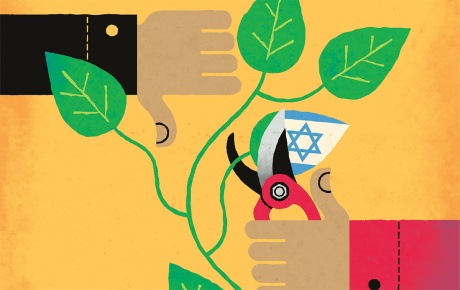Imagine a documentary about a tree. Boring, no? Animal Planet and PBS figured out long ago that people will sit for hours in an easy chair watching nature on a big-screen TV as long as what’s depicted contains plenty of breeding and killing. Trees don’t figure into it much.
Yet trees possess an abundance of something that predators don’t: time. They’re a constant against which we measure change. Their branches support history and memory: the tree of life, the family tree, the tree where man was born. Enlightenment came to the Buddha while he was sitting under a pipal tree, which was then renamed in his honor as the bodhi, or awakening, tree.
Many of us have a tree in the stories we tell ourselves about who we are: the dogwood where the Christmas lights were hung, the pines that made such scary sounds on windy nights, the beech whose fall leaves seemed to store up the diminishing light of the progressively shorter days.
My own tree story involves a box elder or ash-leaf maple, a fast-growing but short-lived tree that even tree-huggers tend to ignore. The leaves of a box elder offer dappled shade at best, and its wood is not even good for burning, but my box elder was the only tree of any size in the yard where I grew up and the only one to ever teach me about hope and, later, death. When my father nailed a nesting box to its trunk one spring, my box elder—it would be at least another decade and a half before I even thought to look up what it was—became the stage on which I first watched a pair of tree swallows mate, nest, and raise their young. I can still see the clean white of their breasts and the deep shiny blue of their slim backs as they traced arcs above the backyard, can still see their tightly wound watchfulness when they paused on the lip of the entrance hole while bringing insects to the young inside. I can still hear their twittering coming through the screens on a summer morning in which the only tasks ahead of a ten-year-old boy were to eat breakfast and resume the long task of preparing himself for his own eventual fledgling.
That’s the hope part of the story. The death part came much later, during college and the years immediately after, when my father increasingly complained about how tall the box elder had become and how many of its long branches now extended above the porch roof. He began to talk about cutting down the tree before a wind storm or lightning strike toppled it onto the house.
It was then that I finally took the trouble to learn, and to tell my father, that the tree was a box elder, hoping, I suppose, that giving it a name might save it. I was surprised at how much I wanted to save it. You see, one of the minor disappointments of my boyhood was that we had no trees big enough to support a tree house, and I very much wanted the sanctuary of a tree house. I watched the box elder closely, waiting for the summer it would be big enough to hold one. Anticipating that summer became one of those intimate threads that bind a father and a son, and it was not until I was out of college that my father and I agreed that the box elder had finally grown big enough. But by then I had fledged, and the tree was doomed.
Late last year, the Brown campus discovered its own tree story, about a magnificent American elm. Four feet in diameter, its trunk rose and then, in typical elm fashion, split into several branches that fan out into a four-story hardwood bouquet. Located on Thayer Street, it dwarfed the new, three-story, Vigñoly-designed Watson Institute building, whose entrance seemed to have stepped back in deference to it. And with good reason. “For a tree, standing high and dry,” David Quammen once wrote in an essay about the biomechanics of trees, “life isn’t so restful as it might seem. Great strength, supple resistance, and prolonged exertion are required. Imagine a chin-up that lasts a century.”
Then the Thayer Street elm was found to be infected with Dutch elm disease, which is always fatal, and which destroyed the American elms on the Main Green decades ago. (The elms growing there now are a resistant strain.) One of the remarkable things about the Thayer Street elm is not that it succumbed to the disease—one theory is that the stress of the Watson building construction may have made it more vulnerable—but that it had resisted it for so long.
“An elm can scarcely grow to old age,” wrote Donald Culross Peattie in his 1964 classic, A Natural History of Trees of Eastern and Central North America, “without collecting rich human associations around it.” Sure enough, as word spread around campus that the Thayer Street elm was to be cut down, a discussion began about preserving its human associations as a way of memorializing what had been one of the neighborhood’s most spectacular trees.
The tree especially caught the imagination of Richard Fishman, the chair of the program in visual arts and a longtime admirer of all things dendrologic. “Our hope,” Fishman wrote in an e-mail distributed to colleagues at Brown and RISD, “is that the tree will live on in a variety of forms appreciated on and around our two campuses.” He then asked for suggestions.
The replies reinforce the evocative, even atavistic, spell a tree can cast. Assistant Professor of Environmental Studies Christina Zarcadoolas suggested sending two graduate students to the cutting and having them intercept onlookers to ask “about their perceptions of the tree and its health, its value” as part of an ethnographic study of people’s perceptions of their environment. Professor of Anthropology William Beeman wrote to support the idea of leaving part of the trunk intact and carving a sculpture out of it. “I am in touch with totem pole carvers in Alaska,” he offered. Professor of Geological Sciences Tom Webb suggested preserving and staining a cross-section of the tree’s trunk in order to examine the tree’s fat and lean growth years. “In a sense,” he wrote, “the tree contains its own history.”
Fishman then took these and other replies and crafted a proposal for what he calls “The Elm Tree Project.” Lasting two years, the project would begin by documenting the cutting of the tree. Its trunk would be carried off to a mill in western Massachusetts, cut into boards, kiln dried, and then used by furniture-making and art classes at RISD and Brown. Smaller branches would be stored near campus and used by art classes for photography, drawing, painting, and sculpture. Faculty members would be invited to incorporate the tree into other courses in a variety of disciplines. There would be a Web site and perhaps a documentary about the two-year project, and at the end, an exhibition of work created from the tree or inspired by it. “Sounds promising,” President Simmons wrote to Fishman in e-mail encouraging him to proceed.
The Thayer Street elm was scheduled to be removed in late December. Whatever objects are made from it, already its human story has begun. If my box elder was part of a narrative of hope and death, the elm’s story is one of persistence and beauty and perception. It’s a tree of human voices and their contrapuntal celebration of the physical world.
“And though elms too are mortal,” wrote Donald Culross Peattie, “great ones are remembered as long after they are gone as are great men. ‘On this spot once an Elm—’ So begins many a marker, many a sentence in a book of local history, as one would say, ‘Here was born a man,’ ‘Here died a king.’”
Norman Boucher is editor of the BAM.





